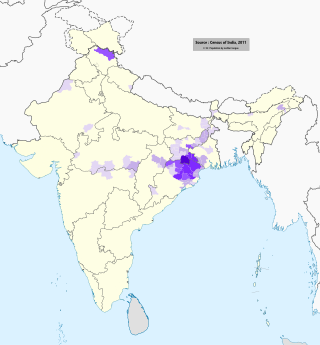
Back Ho Afrikaans हो भाषा ANP اللغة الهويوية Arabic Tataramon na Ho BCL Хо (език) Bulgarian হো ভাষা Bengali/Bangla Hoeg Breton Ho (llengua) Catalan Ho (sprog) Danish Hoki DIQ
This article's tone or style may not reflect the encyclopedic tone used on Wikipedia. (April 2024) |
| Ho | |
|---|---|
| 𑢹𑣉𑣉 𑣎𑣋𑣜, हो जागार, ହୋ ଜାଗାର, হো জাগার | |
 'hōō jagar' written in Warang Citi | |
| Pronunciation | /hoː ʤɐgɐr/ |
| Native to | India |
| Ethnicity | Ho people |
Native speakers | 2.2 Million (2011 census)[1] |
Austroasiatic
| |
| Official: Warang Chiti Secondary: Devanagari, Latin script, Odia script, Telugu script[2] | |
| Official status | |
Official language in |
|
| Language codes | |
| ISO 639-3 | hoc |
| Glottolog | hooo1248 |
 Ho language speaking region | |
 Ho is classified as Vulnerable by the UNESCO Atlas of the World's Languages in Danger[3] | |
Ho (IPA: [/hoː ʤɐgɐr/], Warang Citi: 𑢹𑣉𑣉 𑣎𑣋𑣜) is a Munda language of the Austroasiatic language family spoken primarily in India by about 2.2 million people (0.202% of India's population) per the 2001 census. It is spoken by the Ho, Munda, Kolha and Kol tribal communities of Odisha,[4] Jharkhand, Bihar, Chhattisgarh, West Bengal, Assam and is written with the Warang Citi script. Devanagari, Latin script, Odia script and Telugu script are sometimes used,[5] although native speakers are said to prefer a Ho script.[6] The latter script was invented by Ott Guru Kol Lako Bodra.
The name "Ho" is derived from the native word "𑣙𑣉𑣉" which means "Human being".[7]
- ^ "Statement 1: Abstract of speakers' strength of languages and mother tongues – 2011". www.censusindia.gov.in. Office of the Registrar General & Census Commissioner, India. Retrieved 7 July 2018.
- ^ "Scripts of Ho". Scriptsource.org. Retrieved 26 August 2021.
- ^ Moseley, Christopher; Nicolas, Alexander, eds. (2010). Atlas of the World's Languages in Danger (PDF) (3rd ed.). Paris: UNESCO. pp. 46–47. ISBN 978-92-3-104096-2. Archived from the original on 23 July 2022.
- ^ "Tribals seek official tag for Ho language - OrissaPOST". 27 October 2018. Retrieved 16 December 2019.
- ^ "The Warang Chiti Alphabet". Swarthmore.edu. Retrieved 19 March 2015.
- ^ K David Harrison; Gregory Anderson. "Review of Proposal for Encoding Warang Chiti (Hoorthography) in Unicode" (PDF). Retrieved 19 March 2015.
- ^ "Ho Web Sketch: Ho writing" (PDF). Livingtongues.org. Archived from the original (PDF) on 17 March 2016. Retrieved 19 March 2015.
© MMXXIII Rich X Search. We shall prevail. All rights reserved. Rich X Search